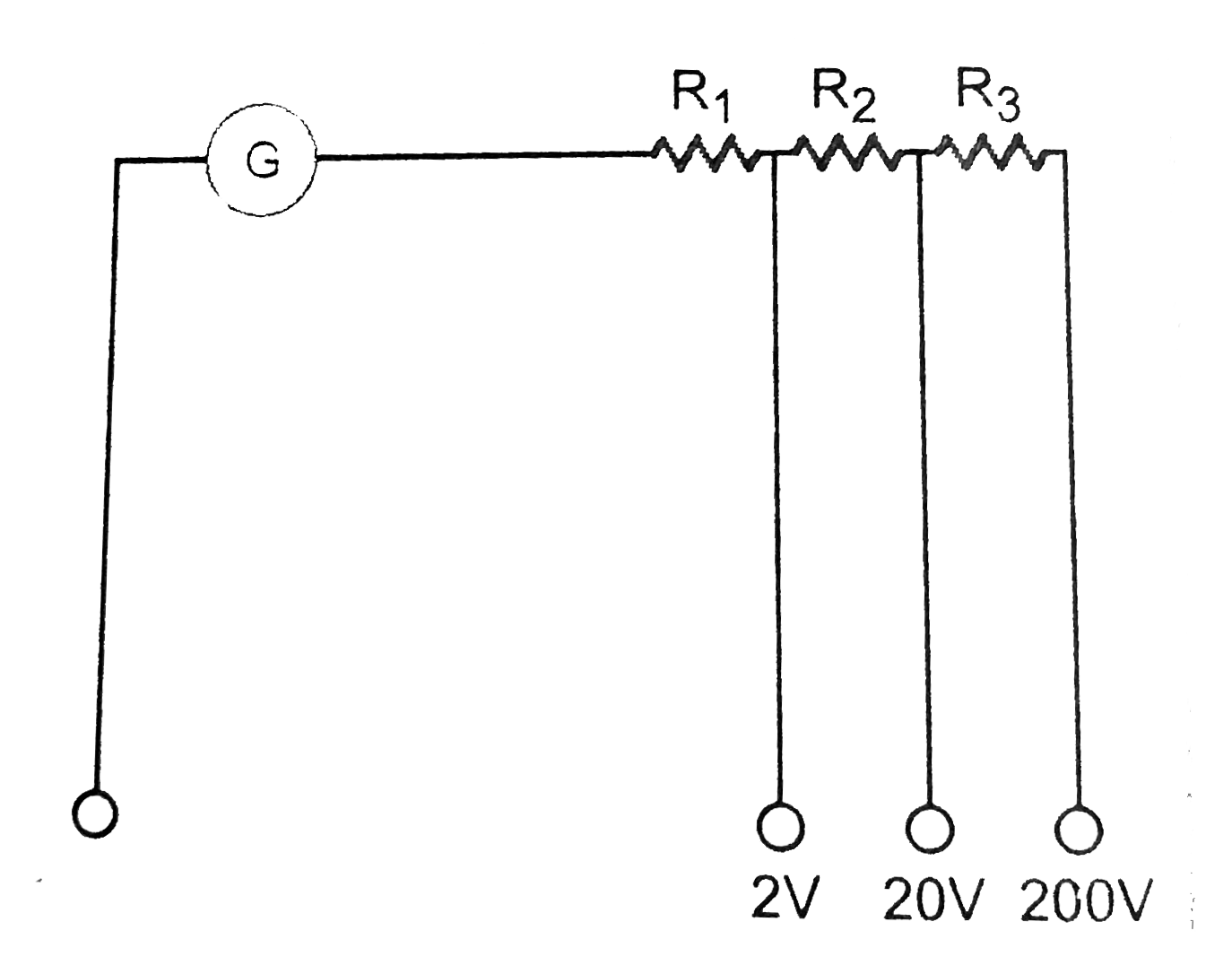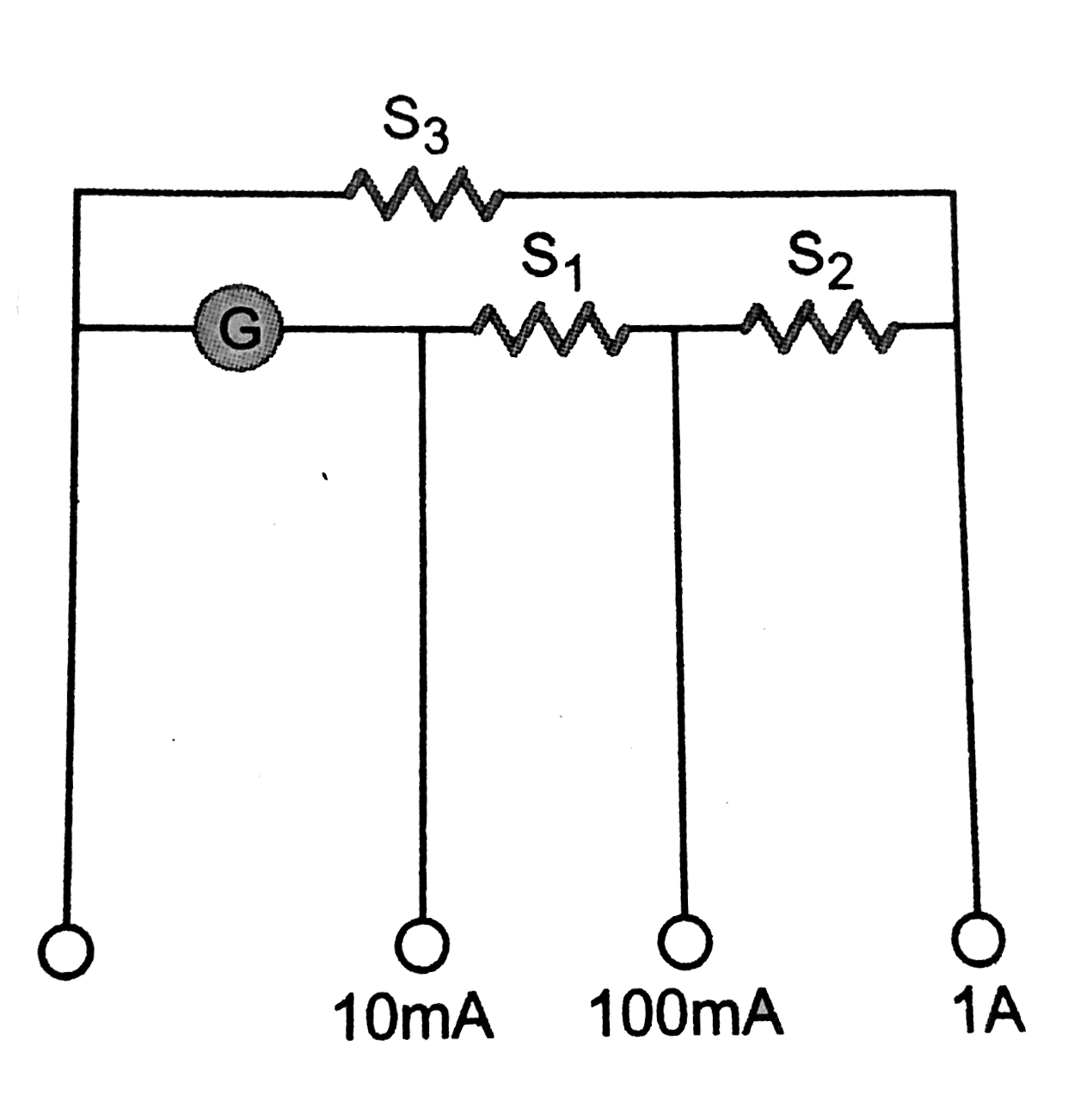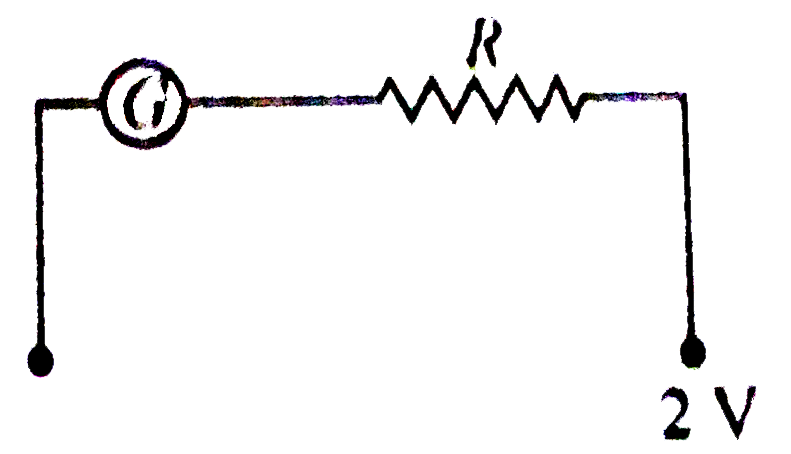A multirange voltmeter can be constructed by using a galvanometer circuit as shown in figure. We want to construct a voltmeter that can measure 2V, 20V and 200V using a galvanometer of resistance 10Ω and that produces maximum deflection for current of 1mA. Find R1, R2 and R3 that have to be used. 
Given,
Resistance of galvanometer, RG=10Ω
Current through the galvanometer,IG=1mA=10−3A
(i) For a voltameter measuring a voltage of 2 V, resistance R1 is connected in circuit with the galvanometer.
∴ IG×(RG+R1)=2
⇒10_3(10+R1)=2
⇒10−2+10−3R1=2
⇒10−3R1=2−0.01
⇒R1=1,990Ω
(ii) For a voltmeter measuring a voltage of 20 V,
resistance R2, is connected in circuit with the galvanometer and resistance R1.
∴IG×(RG+R1+R2)=20
⇒10_3(10+1,990+R2)=20
⇒10−2+1.99+10_3R2=20
⇒10−3R2=20−2
⇒R2=18,000Ω=18kΩ
(iii) For a voltmeter measuring a voltage of 200 V, resistance R3 is connected in circuit with the galvanometer and resistances R1 and R2.
∴IG×(RG+R1+R2+R3)=200
⇒10−3(10+1,990+18,000+R3)=200
⇒10−3(20,000+R3)=200
⇒10−3R3=200−20=180
⇒R3=180000Ω=180kΩ
Topper's Solved these Questions
- BOOK - MODERN PUBLICATIONCHAPTER - MOVING CHARGES AND MAGNETISMEXERCISE - Higher Order Thinking Skills & Advanced Level10videos
MOVING CHARGES AND MAGNETISM
- BOOK - MODERN PUBLICATIONCHAPTER - MOVING CHARGES AND MAGNETISMEXERCISE - Revision Exercises (Very Short Answer Questions )59videos
MOVING CHARGES AND MAGNETISM
- BOOK - MODERN PUBLICATIONCHAPTER - MOVING CHARGES AND MAGNETISMEXERCISE - NCERT (Exemplar Problems ) (Very Short Answer Type Questions )5videos
MOVING CHARGES AND MAGNETISM
- BOOK - MODERN PUBLICATIONCHAPTER - MAGNETISM AND MATTEREXERCISE - CHAPTER PRACTICE TEST FOR BOARD EXAMINATION16videos
MAGNETISM AND MATTER
- BOOK - MODERN PUBLICATIONCHAPTER - NUCLEIEXERCISE - CHAPTER PRACTICE TEST FOR BOARD EXAMINATION15videos
NUCLEI
Similar Questions
A multirange current meter can be constructed by using a galvanometer circuit as shown in figure. We want a current meter that can measure 10mA, 100mA and 1A using a galvanometer of resistance 10Ω and that produces maximum deflection for current of 1mA. Find S1,S2 and S3 that have to be used.
 View Solution
View SolutionA voltmeter which can measure 2 V isconstructed by using a galvanometer of resistance 12Ω and that produces maximum deflection for the current of 2mA. Then the resistance R is
 View Solution
View Solution
Knowledge Check
- Question 1 - Select One
A galvanometer has resistance of 7Ω and given a full scale deflection for a current of 1.0A. How will you convert it into a voltmeter of range 10V
A3Ω in seriesB3Ω in aprallelC17Ω in seriesD30Ω in series - Question 2 - Select One
A galvanometer of internal resistance 100Ω has a full scale deflection current of 1mA. To convert it into a voltmeter of range 0−10V, the resistance to be connected is
A9000 Ω in SeriesB10,000 Ω in SeriesC9,900 Ω in SeriesD9,800 Ω in Series
Hwo can a voltmeter of resistance 200 ohm and measuring 10 V be used tomeasure a current of 5A ?
View Solution" A galvanometer of resistance "20" ohm suffers full scale deflection for a current "20mA" .It can be converted a Voltmeter of range "200V" by "
View SolutionA galvanometer has coil resistance 30Ω and full deflection current of 2mA. What resistance is needed to convert it into a voltmeter of 0.2V range.
View SolutionCalculate the value of resistance needed to convert a galvanometer of resistance 200Ω, which gives a full scale deflection for a current of 5 mA, into a voltmeter of 0-10V range.
View SolutionHow can we make a galvanometer with G=20Ω and ig=1.0mA into a voltmeter with a maximum range of 10V?
View SolutionA galvanometer of resistance 20 ohm suffers full scale deflection for a current 20mA .It can be converted a Voltmeter of range 200V by
View Solution

